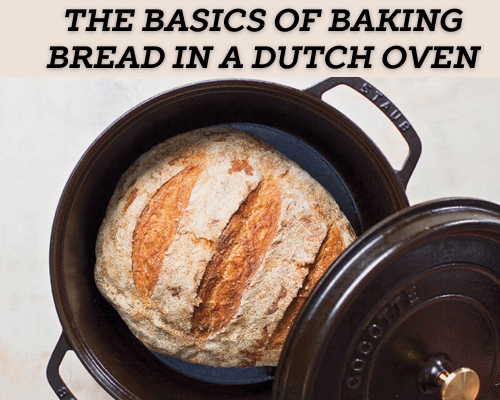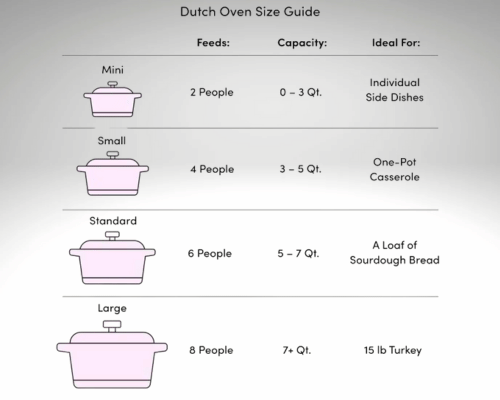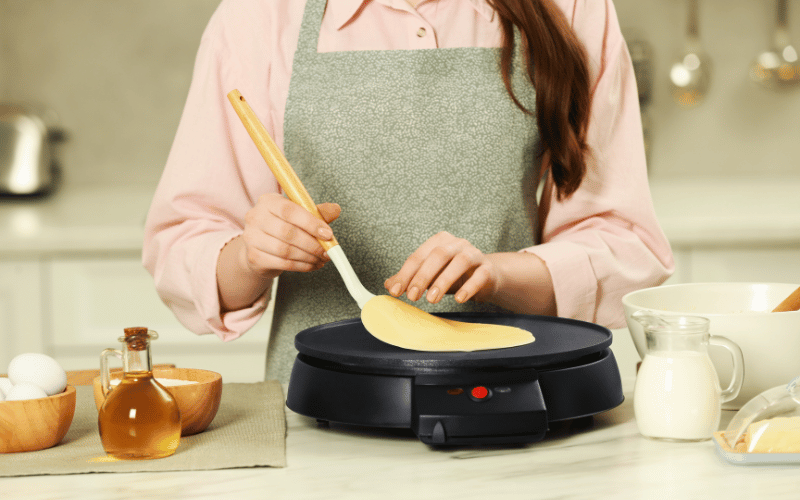What makes a Dutch oven different from a regular one? A Dutch oven contains steam, which causes the bread to steam on its own. Because of this, the bread acquires a crisp, browned crust that would not be possible in a typical oven. Is that all? I am afraid it’s not. We will learn about Dutch ovens in as much detail as we can, including the ideal size for baking bread.
Table of Contents
The Basics of Baking Bread in a Dutch Oven

The main reason behind using the Dutch oven for baking bread is to utilize the power of the steam. Steam is essential for ensuring that the bread bakes evenly on all sides. On top of that, steam helps build a perfect crust on bread in the initial stage of baking. When we place the dough inside a preheated Dutch oven and cover it with a lid, it creates a sealed and closed environment inside. This environment traps the steam and gives the bread a gorgeously browned crust. Trapped steam also prevents the bread from drying too early, and early drying of the bread will prevent further growth.
Dutch ovens are made of a variety of materials, including ceramic and cast iron. Even though ceramic-made Dutch ovens are light and very easy to clean, we advise against using them. Dutch ovens made of ceramic cannot be used with all types of heat sources and are not non-stick. On the other hand, cast-iron Dutch oven walls are thick, so heat is distributed evenly. There will not be a hot spot to worry about, and the bread will bake slowly but beautifully.
The Role of Dutch Oven Size in Baking Bread
Oven size is important in bread baking. The size of the oven has a big effect on the bread’s size and shape. You will not be able to get the desired crust and size in a smaller Dutch oven because there will not be as much room for the dough to expand. The ideal size of a Dutch oven will provide the dough with additional room to expand, and the dough will eventually be baked into a loaf of bread in good shape.
Smaller Dutch ovens typically have less horizontal space, which causes bread to become tall and narrow. However, a larger Dutch oven guarantees wider bread with an ideal shape.
It does not specifically say that you can’t bake in a smaller Dutch oven; you may just need to adjust the amount of dough. Simple: Smaller Dutch ovens bake smaller breads.
Key Factors to Consider While Choosing The Size of The Dutch Oven
The type of bread you want to bake, how many people you plan to serve, the space in the oven that is available, or even just the size of your family are all things to take into account when selecting the right size Dutch oven. Choose a mid-size Dutch oven with a capacity between 4 and 6 quarts if you want to bake round or rustic loaves like boules.
A medium-sized Dutch oven will produce the desired shape and crust since boules are typically short and wider. Traditional baguettes cannot be baked in a Dutch oven because of how long and narrow they are. However, a Dutch oven can be used to bake different kinds of bread, such as ciabatta. In that case, you either need a very large oven or you need to bake very small loaves of bread.
A 3- to 4-quart Dutch oven will be sufficient if your main purpose for using it is to bake bread for yourself or a small family. If you have a larger family or if you enjoy baking extra loaves, a 5- to 7-quart Dutch oven will be suitable for you. Additionally, you can bake several loaves of bread at once.
Common Dutch Oven Size for Bread Baking

There are multiple sizes of Dutch ovens available on the market. The advantages and disadvantages of each size of Dutch oven will now be discussed.
3-Quart Dutch Oven: If you bake smaller loaves, 3-quart Dutch ovens are perfect for you. It takes up less space when not in use and preheats more quickly due to its small size. If you have a family of more than two people, we do not advise using it because it will produce smaller loaves and offer less room for bread expansion.
5-Quart Dutch Oven: 5-quart Dutch ovens are suitable for average bread baking. Their versatility offers a balance between loaf size and flexibility. With this Dutch oven, a family of three to four people can easily meet their bread needs. Even though the size of the Dutch oven may have an impact on how the crust develops, occasionally the loaf may not fit completely inside (depending on the recipe).
6-Quart Dutch Oven: A 6-Quart Dutch oven is an ideal choice for the Dutch oven. We advise using this Dutch oven if you only need to bake a loaf of bread that is about average in size and are not going to use it for a big event. It does not take up more room and preheats fairly quickly.
7-Quart Dutch Oven: A 7-quart Dutch oven can fulfill a typical family’s bread needs. It is the perfect option for larger loaves and allows for excellent internal bread expansion. This Dutch oven is capable of baking bread of various sizes. In addition, this oven will take longer to pre-heat because of its larger size and take up more storage space when not in use.
9-Quart Dutch Oven: A 9-quart or larger Dutch oven is essentially required for larger gatherings or events where a sizable quantity of bread is required. This oven allows you to bake several loaves of bread at once and save time. When not in use, it occupies a lot more room and preheats very slowly.
Expert Tips for Selecting the Right Size
Many expert bakers have valuable advice about choosing the perfect size Dutch oven. The founder of Tartine Bakery, Chad Roberston, advises using a 4- to 5-quart Dutch oven. He recommends it for his most popular country bread recipe. He points out that the 4- to 5-quart Dutch oven’s ideal interior space ensures that the bread will expand and hydrate well. The world-famous chef Ken Forkish suggests using a 4- to 7-quart Dutch oven in his book “Flour Water Salt Yeast”.
You can also adapt recipes to different Dutch oven sizes using Ken’s formula. That formula ensures your dough fills about 70% to 80% of the Dutch oven’s volume, giving impressive crust development with proper bread expansion. Peter Reinhart from The Bread Baker’s Apprentice recommends using a 5- to 7-quart Dutch oven for most artisan bread recipes. The King Arthur Baking Company suggests a 4- to 6-quart Dutch oven for the majority of their bread recipes.
Real-Life Examples and Experiences
Patricia, one of my coworkers, was searching for the ideal Dutch oven for baking bread. She made her first batch in a 4-quart Dutch oven, which resulted in tall loaves with a thick crust, but she felt unable to share those small loaves with friends or family. However, she wanted a bit more crumb and a lighter crust. So, she decided to try a 6-quart Dutch oven based on advice from a fellow baker. The outcomes were exactly what she was expecting! The ideal size for sharing with friends and family, with a lighter crumb and a thinner, crisper crust.
One of my closest friends, Mark, has been obsessed with cooking since childhood. He normally bakes using a 7-quart Dutch oven, and his bread is consistently good. Once, he experimented with a 4-quart Dutch oven for a thicker crust. After some failed experiments, he was able to find the way to get the perfect crust he was expecting. He had to reduce the dough quantity, and the adjustment took multiple doughs to burn and rot.
While Patricia was not able to achieve the results she was hoping for, Mark still used the same 4-quart Dutch oven to produce the ideal results. There is no magic or spell to obtain the perfect moisture; you just need to adjust the dough amount according to the Dutch oven size.
Choosing the Right Dutch Oven Brand
There are numerous reliable brands of Dutch ovens available. Here are some popular brands to think about, along with some drawbacks.
Staub: Staub is a well-known producer of cast iron Dutch ovens with enamel that are renowned for their exceptional heat retention and self-basting lids. They come with a premium price tag due to their durability and performance.
Le Creuset: Le Creuset is also famous for its enameled, high-quality cast iron Dutch ovens. With the same price as Staub, they provide excellent heat retention and even cooking.
Lodge: Lodge Dutch ovens feature seasoned cast iron material. Their Dutch ovens are affordable compared to other brands and also provide durability and excellent heat distribution.
Cuisinart: Cuisinart comes with both enameled cast iron Dutch ovens and stainless steel Dutch ovens. They are one of the top mid-budget Dutch oven manufacturers with excellent quality. Their cast iron models are very durable, while their stainless steel models are reasonably priced and have decent performance.
Emile Henry: Emile Henry Dutch ovens are a popular mid-range price range of ovens that offer a respectable balance between cost and quality. Their ceramic Dutch ovens are excellent for moisture retention.
Calphalon: Calphalon is famous for its stainless steel and non-stick Dutch ovens. Their stainless steel model is a budget-friendly Dutch oven and offers impressive durability.
Tramontina: Tramontina is a type of manufacturer that offers cast iron Dutch ovens of magnificent quality. Their Dutch ovens offer excellent value for money and impressive cooking capabilities.
Great Jones: If you are looking for fashionable enameled cast iron Dutch ovens, Great Jones might be your best bet. Their Dutch ovens perform admirably and are also very user-friendly, practical, and attractive. They offer vibrant colors in Dutch ovens and have a mid-to-high price range.
Tips for Maintaining Your Dutch Oven
Your Dutch oven will last longer if you maintain and care for it properly. If you have an enameled cast iron Dutch oven, initial seasoning is important before using it for the first time. Apply vegetable oil to the inside of your Dutch oven and bake it for at least an hour at 175°C. This procedure can be repeated several times to create a nonstick patina. The interior of the Dutch oven should be properly cleaned, dried, and oiled after each use. By doing this, you can keep the seasoning and avoid rust.
Never put your Dutch oven in the dishwasher, and never wash it using any harsh detergent. Instead, use warm water and clean it by hand or with a sponge. Also, never soak your Dutch oven in water for a long time; try using minimal water during cleaning. After cleaning, always make sure to properly dry the item; set it on a stove over low heat to guarantee that all moisture is removed.
For maximum longevity, store the Dutch oven in a dry place to prevent moisture. To avoid damaging the surface enamel, avoid abrupt temperature changes. Let the Dutch oven cool down before washing it if it is made of ceramic.
Conclusion
Choosing the right Dutch oven size is important to achieve your desired result. A 5- to 7-quart Dutch oven would be ideal for baking a medium-sized boule because it would produce the ideal crust and crumb. But what if you wanted to bake baguettes? What if you purchased a 5-quart Dutch oven and now want to bake a large ciabatta? There is no such thing as an ideal-sized Dutch oven.
Your needs and what you want to bake are the only things to think about while choosing the Dutch oven. To be very honest, if you are unsure of your needs, you might need to test out several Dutch ovens.
Be adamant about what you truly desire. Before selecting the appropriate size Dutch oven, it is important to consider your family size, desired bread, potential recipes, and any occasional large events. However, there is a benefit to using a larger Dutch oven than a 5-quart one.
They do not take up much room and can still produce reasonable-sized bread loaves. Furthermore, we advise getting the Dutch oven that is the proper size for your needs.
You can see also: Kitchen Must Do Before Vacation

Hey There, I’m Monica, Mom of two. This is my personal blog site. Here I write about Kitchen Tips Tricks, Recipes, and Review the products I use.
I hope you enjoy the article. Give me feedback on how I’m doing with my blog. I would appreciate it so much.
Have a great day! 🙂
[Follow me on Twitter]


